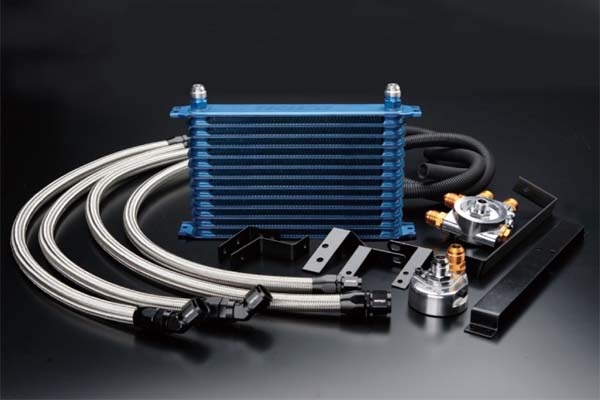Cooling System
6.0 Oil Cooler Relocation Kit: Ford Upgrade

Motor oil doesn’t just keep parts lubricated, it also helps keep your engine cool. As it passes through the cylinder head and around the combustion chamber, oil absorbs heat, transferring it across the engine block. In most engines, the transfer of heat between the oil, block, and coolant is enough to keep temperatures under control.
Some engines, like the 6.0 Powerstroke, take this a step further by adding a cooler to extract heat directly from the oil. While the 6.0’s cooler is effective, it also has a history of pattern failures. These problems can be addressed by installing a 6.0 oil cooler relocation kit or a complete 6.0 Powerstroke oil cooler upgrade.
Common Problems with the Stock Powerstroke Oil Cooler
The 6.0l Powerstroke uses an oil-to-water cooler. Oil and coolant pass through a series of small channels inside the cooler. This transfers heat from the oil to the coolant. From there, the coolant releases heat through the radiator. While this is effective, the design is known for frequent failures that may put your engine at risk of overheating and mechanical problems.
The passages inside the oil cooler are tiny. While this increases their surface area for better heat transfer, it also makes these passages easier to clog. Contaminants in the cooling system from corrosion, additives, and gasket material can work their way to the cooler, which may seal up passages over time. It’s possible for dirt, soot, and sludge to cause the same blockages on the oil side of the cooler.
The oil cooler sits in the valley of the engine, where it’s exposed to massive amounts of heat. This reduces cooling efficiency, and it increases thermal stress on the cooling block. Over time, this heat stress may lead to splits in the fluid passages, allowing the oil and coolant to mix. This creates a sticky emulsion that may block the lubrication system, the cooling system, or both.
The oil cooler bolts directly to the feed for the high-pressure oil pump (HPOP). There’s a chance that the HPOP filter screen will fail as it ages, eventually leading to oil pump failure. The oil supplied by the HPOP drives the fuel injectors. Even if the pump is still working, debris passing through a broken filter could find its way into the injector supply lines, clogging them.
Symptoms of a Failing Oil Cooler
If the oil cooler is working effectively, the oil temperature and coolant temperature should be about the same. Oil temperatures more than 15 degrees warmer than the coolant temperature may indicate a failing cooler. Over time, increased oil temperatures may lead to premature failure of mechanical components, particularly in high-stress situations, like climbing hills or towing near the vehicle’s payload limit.
After passing through the oil cooler, antifreeze enters the EGR cooler. If the movement of coolant is restricted in the oil cooler, it may lead to overheating and eventual failure of the EGR cooler. This can be caused by passages blocked by debris or emulsified coolant.
How Do I Fix My Powerstroke’s Oil Cooler Problems?
BulletProof Diesel offers two solutions that address the pattern failures of the stock oil cooler. Installing a 6.0 oil cooler relocation kit moves the cooler away from the engine, lowering operating temperatures. Our 6.0 Powerstroke remote oil cooler kits replace the oil-to-water cooler with an oil-to-air cooler. Which kit is the best oil cooler for 6.0 Powerstroke owners? It depends on how much work you want to do and how you use your truck.
What’s the Difference Between Oil-to-Water and Oil-to-Air Coolers?
Our oil cooler relocation kit moves the stock cooler out of the engine valley. This keeps the stock oil-to-water cooling setup. The cooler mounts to a bracket that attaches to the truck next to the passenger side battery. To make room, the kit includes a replacement vacuum reservoir that replaces the large OEM unit. Hoses transfer oil and coolant between the cooler and a fluid transfer block that mounts to the stock cooler location. Once installed, the cooler can be accessed without removing the intake manifold and turbocharger.
Our 6.0 Powerstroke remote oil cooler kits replace the stock oil-to-water cooler with an oil-to-air cooler. This cools the oil directly using a radiator, eliminating engine coolant from the system entirely. That means there’s no way for coolant and oil to mix at this point in the engine.
An oil transfer block replaces the oil-to-water cooling block. This meets up with the original oil passages, sending oil through a hose to the included radiator. This oil cooling radiator sits between the grille and the air conditioner condenser. A return line sends the cooled oil back to the transfer block, where it is filtered before going into the HPOP.
Installing a relocation kit is easier than installing an oil-to-air cooling kit. The oil-to-air kit requires the removal of the air conditioner condenser. If you want to do this upgrade yourself, you will need to have your A/C system drained of coolant before installation.
The transfer blocks on the relocation kit and upgrade kit both have an integrated HPOP screen, replacing the failure-prone stock screen. Oil-to-air cooler kits are available with an oil filter relocation kit. This replaces the engine’s cartridge filter with a larger, easier to access can-style filter that mounts to the left of the engine.
What’s the Difference Between a Hot Climate Cooler and an All Climate Cooler?
Our hot climate coolers circulate oil through the cooling system 100% of the time for the best performance at high ambient temperatures. Our all climate coolers have a built-in thermostat that bypasses the cooling system until the oil is warm. This helps the engine warm-up in cold weather. Don’t worry if you install a hot weather kit, then move or change routes to a cooler climate. We offer a thermostat and bypass hose kit, letting you turn your hot climate cooler into an all-weather cooler.
What Do I Need to Install One of These Kits?
Most of the parts you will need are included with these installation kits. However, there are a few extra parts and modifications you may need, depending on the stock components used to build your truck.
– An extra bracket is needed for 03-07 trucks with an upgraded air conditioner condenser. This condenser uses a wider block for the refrigerant lines, which gets in the way of the oil cooler. Most replacement condensers, whether they’re OEM or aftermarket, use this wider design.
– 06-07 trucks moved the power steering cooler from the bottom of the radiator support to the top. This cooler needs to be relocated to the bottom using our power steering cooler relocation kit.
– Some early 2003 engines use a thread-on turbo oil feed tube. This should be replaced with an O-ring fitting tube.
– Some trucks have a 17 inch transmission cooler, while others have a 14 inch cooler. If your truck has the larger cooler, it can be moved down using the brackets included with the kit, giving you space to install the oil cooler.
– If you’re installing an external oil filter and you live in an area where the roads are salted, you may want to cover the fittings with a rubberized undercoating to prevent corrosion. Undercoating spray should be available at your local parts store.
When You Want the Best Oil Cooler for 6.0 Powerstroke Engines, Go With BulletProof
Whether you have a performance engine, or you want to reduce the chance of breakdowns in your hauling rig, you can rely on BulletProof’s oil cooler solutions. We make it easy to install a 6.0 Powerstroke oil cooler upgrade on your truck. You can order a kit and any accessories you need from us directly. We include easy-to-follow instructions, walking you through each step of the installation process. Don’t want to deal with removing and installing major engine components? We have a network of preferred installers. These professionals have experience with our components, so you can be sure your BulletProof oil cooler or relocation kit will be installed correctly.





